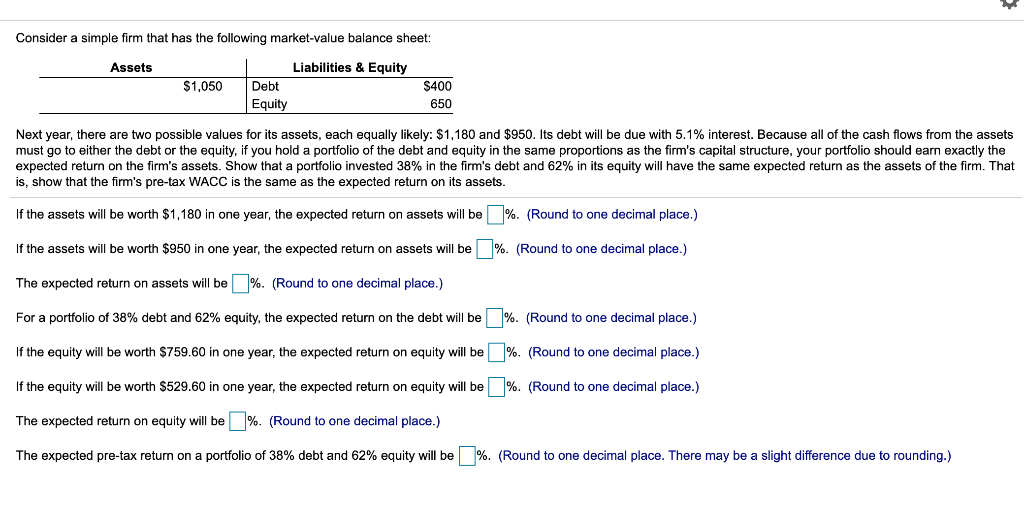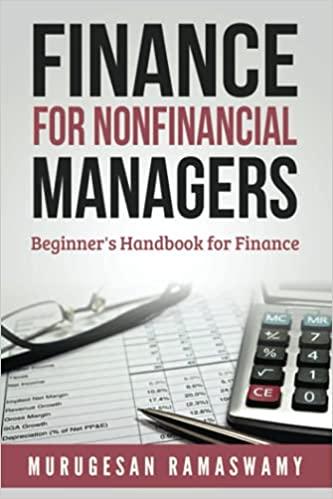Question
Consider a simple firm that has the following market-value balance sheet: Next year, there are two possible values for its assets, each equally likely: $1,180
 Consider a simple firm that has the following market-value balance sheet:
Consider a simple firm that has the following market-value balance sheet:
Next year, there are two possible values for its assets, each equally likely: $1,180 and $950. Its debt will be due with 5.1% interest. Because all of the cash flows from the assets must go to either the debt or the equity, if you hold a portfolio of the debt and equity in the same proportions as the firm's capital structure, your portfolio should earn exactly the expected return on the firm's assets. Show that a portfolio invested 38% in the firm's debt and 62% in its equity will have the same expected return as the assets of the firm. That is, show that the firm's pre-tax WACC is the same as the expected return on its assets.
Consider a simple firm that has the following market value balance sheet: Assets Liabilities & Equity $1,050 I Debt Equity $400 650 Next year, there are two possible values for its assets, each equally likely: $1,180 and $950. Its debt will be due with 5.1% interest. Because all of the cash flows from the assets must go to either the debt or the equity, if you hold a portfolio of the debt and equity in the same proportions as the firm's capital structure, your portfolio should earn exactly the expected return on the firm's assets. Show that a portfolio invested 38% in the firm's debt and 62% in its equity will have the same expected return as the assets of the firm. That is, show that the firm's pre-tax WACC is the same as the expected return on its assets. If the assets will be worth $1,180 in one year, the expected return on assets will be %. (Round to one decimal place.) If the assets will be worth $950 in one year, the expected return on assets will be %. (Round to one decimal place.) The expected return on assets will be %. (Round to one decimal place.) For a portfolio of 38% debt and 62% equity, the expected return on the debt will be %. (Round to one decimal place.) If the equity will be worth $759.60 in one year, the expected return on equity will be %. (Round to one decimal place.) If the equity will be worth $529.60 in one year, the expected return on equity will be %. (Round to one decimal place.) The expected return on equity will be %. (Round to one decimal place.) The expected pre-tax return on a portfolio of 38% debt and 62% equity will be %. (Round to one decimal place. There may be a slight difference due to rounding.) Consider a simple firm that has the following market value balance sheet: Assets Liabilities & Equity $1,050 I Debt Equity $400 650 Next year, there are two possible values for its assets, each equally likely: $1,180 and $950. Its debt will be due with 5.1% interest. Because all of the cash flows from the assets must go to either the debt or the equity, if you hold a portfolio of the debt and equity in the same proportions as the firm's capital structure, your portfolio should earn exactly the expected return on the firm's assets. Show that a portfolio invested 38% in the firm's debt and 62% in its equity will have the same expected return as the assets of the firm. That is, show that the firm's pre-tax WACC is the same as the expected return on its assets. If the assets will be worth $1,180 in one year, the expected return on assets will be %. (Round to one decimal place.) If the assets will be worth $950 in one year, the expected return on assets will be %. (Round to one decimal place.) The expected return on assets will be %. (Round to one decimal place.) For a portfolio of 38% debt and 62% equity, the expected return on the debt will be %. (Round to one decimal place.) If the equity will be worth $759.60 in one year, the expected return on equity will be %. (Round to one decimal place.) If the equity will be worth $529.60 in one year, the expected return on equity will be %. (Round to one decimal place.) The expected return on equity will be %. (Round to one decimal place.) The expected pre-tax return on a portfolio of 38% debt and 62% equity will be %. (Round to one decimal place. There may be a slight difference due to rounding.)Step by Step Solution
There are 3 Steps involved in it
Step: 1

Get Instant Access to Expert-Tailored Solutions
See step-by-step solutions with expert insights and AI powered tools for academic success
Step: 2

Step: 3

Ace Your Homework with AI
Get the answers you need in no time with our AI-driven, step-by-step assistance
Get Started


